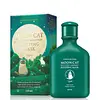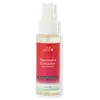What's inside
What's inside
 Key Ingredients
Key Ingredients

 Benefits
Benefits

 Ingredients Side-by-side
Ingredients Side-by-side

Water
Skin Conditioning1,2-Hexanediol
Skin ConditioningNiacinamide
SmoothingCaprylic/Capric Triglyceride
MaskingHelianthus Annuus Seed Oil
EmollientCamellia Sinensis Leaf Water
MaskingDicaprylyl Ether
EmollientSqualane
EmollientPhoenix Dactylifera Fruit Extract
EmollientFicus Carica Fruit Extract
HumectantOpuntia Ficus-Indica Extract
Skin ConditioningAdansonia Digitata Seed Extract
Skin ConditioningPortulaca Oleracea Extract
Skin ConditioningOpuntia Coccinellifera Fruit Extract
Skin ConditioningNelumbo Nucifera Germ Extract
Skin ConditioningBrassica Oleracea Italica Extract
AstringentCeramide NP
Skin ConditioningTrehalose
HumectantPanthenol
Skin ConditioningMacadamia Ternifolia Seed Oil
EmollientXylitol
HumectantCaprylic Acid
CleansingMadecassoside
AntioxidantAsiaticoside
AntioxidantMelia Azadirachta Leaf Extract
Skin ConditioningHydrogenated Lecithin
EmulsifyingMelia Azadirachta Flower Extract
Skin ConditioningHouttuynia Cordata Extract
Skin ConditioningVegetable Oil
Skin ConditioningCoccinia Indica Fruit Extract
Skin ConditioningCentella Asiatica Leaf Extract
Skin ConditioningSolanum Melongena Fruit Juice
Skin ConditioningAmber Powder
Sodium Hyaluronate
HumectantCurcuma Longa Root Extract
MaskingOcimum Sanctum Leaf Extract
Skin ConditioningDipotassium Glycyrrhizate
HumectantTocopherol
AntioxidantMoringa Oleifera Seed Oil
EmollientCorallina Officinalis Extract
Skin ConditioningSodium Polyacrylate
AbsorbentAllantoin
Skin ConditioningGlyceryl Stearate
EmollientButylene Glycol
HumectantXanthan Gum
EmulsifyingAdenosine
Skin ConditioningGlycerin
HumectantDisodium EDTA
Ethylhexylglycerin
Skin ConditioningPentylene Glycol
Skin ConditioningCaprylyl Glycol
EmollientWater, 1,2-Hexanediol, Niacinamide, Caprylic/Capric Triglyceride, Helianthus Annuus Seed Oil, Camellia Sinensis Leaf Water, Dicaprylyl Ether, Squalane, Phoenix Dactylifera Fruit Extract, Ficus Carica Fruit Extract, Opuntia Ficus-Indica Extract, Adansonia Digitata Seed Extract, Portulaca Oleracea Extract, Opuntia Coccinellifera Fruit Extract, Nelumbo Nucifera Germ Extract, Brassica Oleracea Italica Extract, Ceramide NP, Trehalose, Panthenol, Macadamia Ternifolia Seed Oil, Xylitol, Caprylic Acid, Madecassoside, Asiaticoside, Melia Azadirachta Leaf Extract, Hydrogenated Lecithin, Melia Azadirachta Flower Extract, Houttuynia Cordata Extract, Vegetable Oil, Coccinia Indica Fruit Extract, Centella Asiatica Leaf Extract, Solanum Melongena Fruit Juice, Amber Powder, Sodium Hyaluronate, Curcuma Longa Root Extract, Ocimum Sanctum Leaf Extract, Dipotassium Glycyrrhizate, Tocopherol, Moringa Oleifera Seed Oil, Corallina Officinalis Extract, Sodium Polyacrylate, Allantoin, Glyceryl Stearate, Butylene Glycol, Xanthan Gum, Adenosine, Glycerin, Disodium EDTA, Ethylhexylglycerin, Pentylene Glycol, Caprylyl Glycol
Citrullus Lanatus Fruit Water
Skin ConditioningAloe Barbadensis Leaf Juice
Skin ConditioningCucumis Sativus Fruit Water
Skin ConditioningSodium Hyaluronate
HumectantPolyglutamic Acid
Skin ConditioningOpuntia Ficus-Indica Extract
Skin ConditioningCamellia Sinensis Leaf Extract
AntimicrobialNiacinamide
SmoothingChondrus Crispus Extract
Skin ConditioningSodium PCA
HumectantLycium Barbarum Fruit Extract
AstringentSqualane
EmollientGlycerin
HumectantCitrullus Lanatus Fruit Extract
Skin ConditioningDehydroacetic Acid
PreservativeCitrullus Lanatus Fruit Water, Aloe Barbadensis Leaf Juice, Cucumis Sativus Fruit Water, Sodium Hyaluronate, Polyglutamic Acid, Opuntia Ficus-Indica Extract, Camellia Sinensis Leaf Extract, Niacinamide, Chondrus Crispus Extract, Sodium PCA, Lycium Barbarum Fruit Extract, Squalane, Glycerin, Citrullus Lanatus Fruit Extract, Dehydroacetic Acid
Ingredients Explained
These ingredients are found in both products.
Ingredients higher up in an ingredient list are typically present in a larger amount.
Glycerin is already naturally found in your skin. It helps moisturize and protect your skin.
A study from 2016 found glycerin to be more effective as a humectant than AHAs and hyaluronic acid.
As a humectant, it helps the skin stay hydrated by pulling moisture to your skin. The low molecular weight of glycerin allows it to pull moisture into the deeper layers of your skin.
Hydrated skin improves your skin barrier; Your skin barrier helps protect against irritants and bacteria.
Glycerin has also been found to have antimicrobial and antiviral properties. Due to these properties, glycerin is often used in wound and burn treatments.
In cosmetics, glycerin is usually derived from plants such as soybean or palm. However, it can also be sourced from animals, such as tallow or animal fat.
This ingredient is organic, colorless, odorless, and non-toxic.
Glycerin is the name for this ingredient in American English. British English uses Glycerol/Glycerine.
Learn more about GlycerinNiacinamide is a multitasking form of vitamin B3 that strengthens the skin barrier, reduces pores and dark spots, regulates oil, and improves signs of aging.
And the best part? It's gentle and well-tolerated by most skin types, including sensitive and reactive skin.
You might have heard of "niacin flush", or the reddening of skin that causes itchiness. Niacinamide has not been found to cause this.
In very rare cases, some individuals may not be able to tolerate niacinamide at all or experience an allergic reaction to it.
If you are experiencing flaking, irritation, and dryness with this ingredient, be sure to double check all your products as this ingredient can be found in all categories of skincare.
When incorporating niacinamide into your routine, look out for concentration amounts. Typically, 5% niacinamide provides benefits such as fading dark spots. However, if you have sensitive skin, it is better to begin with a smaller concentration.
When you apply niacinamide to your skin, your body converts it into nicotinamide adenine dinucleotide (NAD). NAD is an essential coenzyme that is already found in your cells as "fuel" and powers countless biological processes.
In your skin, NAD helps repair cell damage, produce new healthy cells, support collagen production, strengthen the skin barrier, and fight environmental stressors (like UV and pollution).
Our natural NAD levels start to decline with age, leading to slower skin repair, visible aging, and a weaker skin barrier. By providing your skin niacinamide, you're recharging your skin's NAD levels. This leads to stronger, healthier, and younger looking skin.
Another name for vitamin B3 is nicotinamide. This vitamin is water-soluble and our bodies don't store it. We obtain Vitamin B3 from either food or skincare. Meat, fish, wheat, yeast, and leafy greens contain vitamin B3.
The type of niacinamide used in skincare is synthetically created.
Learn more about NiacinamideOpuntia Ficus-Indica Extract comes from the cactus known as Prickly Pear. Prickly Pear extract has soothing and antioxidant properties.
The flavonoids in prickly pear help reduce inflammation. Prickly pear is also rich in polyphenols, a potent antioxidant.
Sodium Hyaluronate is hyaluronic acid's salt form. It is commonly derived from the sodium salt of hyaluronic acid.
Like hyaluronic acid, it is great at holding water and acts as a humectant. This makes it a great skin hydrating ingredient.
Sodium Hyaluronate is naturally occurring in our bodies and is mostly found in eye fluid and joints.
These are some other common types of Hyaluronic Acid:
Learn more about Sodium HyaluronateSqualane is an emollient that helps the skin hold onto moisture. It's an oily liquid that occurs naturally in certain types of fish and plant oils.
Because squalane boosts hydration in the skin, it also comes with plenty of benefits: it is an antioxidant and can help fight free radicals and skin damage. Squalane is also found to have a detoxifying effect when applied.
Squalane comes from squalene, which occurs naturally within the sebum of our skin. It is one of the oils our skin produces to keep itself hydrated. Squalane is the hydrogenated version of squalene and has a longer shelf life.
Research shows that squalane is non-irritating (even at 100% concentration).
In general, it's a fantastic ingredient. It does a great job at hydrating the skin, and it's suitable for those with sensitive skin.
The source of squalane may impact malassezia / fungal acne. This is because olive oil derived squalane can contain impurities such as fatty acids and plant waxes. Sugarcane derived squalane is recommended for anyone with malassezia concerns.
Is squalane vegan?
This depends on the source. Squalane can be derived from both plants and animals. Most squalane used in skincare comes from plants.
Please note: the source of squalane is only known if disclosed by the brand. We recommend reaching out to the brand if you have any questions about their squalane.
Read more about squalene with an "e".
Is squalane an oil?
Squalane is often called an oil, but it’s technically not; it’s a hydrocarbon, meaning it’s only made of carbon and hydrogen, unlike true oils which are triglycerides made of fatty acids and glycerol.
The term “oil-free” isn’t regulated, so companies can define it however they want. Some exclude all oils, while others just avoid mineral oil or comedogenic oils.
While some people avoid oils thinking they cause breakouts, the right kind of oil (or oil-like ingredient like squalane) can actually help balance and hydrate your skin. It’s worth testing out simple oils or squalane to see what works best for your skin.
Learn more about Squalane